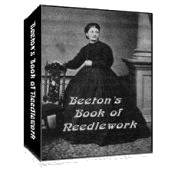Arrasene Embroidery

Arrasene on Plush
Click graphic for more more detail.
Arrasene, also spelled arasene, is an embroidery material that was very popular during Victorian times but is not seen much today. It was introduced for artistic embroidery around 1883 and was thought to likely supersede Filoselle and Crewels in all kinds of bold designs in decorative needlework.
Here is an excerpt from the Manual of Needlework, dated 1883, regarding this material:
It is a kind of fine chenille, comes in both silk and wool, and in all the beautiful varieties of color necessary for shading. It is suitable thus not only for all kinds of home decoration, but also for embroidering articles of wearing apparel, and it is equally suitable for the finest fabrics, as well as the cheaper materials used in needlework.

It is very easy to work, and much more rapidly done than the crewel work, although much the same stitch is required, cording or stem-stitch being about the best stitch to use, with this difference, that the stitch should be about a quarter of an inch on the surface of the material, and a much shorter stitch used underneath, which is not only more economical in the use of the thread, but also brings the fibers closer together on the work, giving a richer appearance to it when finished. Sometimes in smaller flowers on velvet, or plush, it is sewed upon the surface without being drawn through. A chenille or rug needle should be used, with an eye large enough to let the thread pass through without displacing the fiber, and also that the fiber should not be injured in passing through the material. It must always be cut in short lengths, as it wears off, after repeatedly being drawn through the work, particularly if the fabric is fine.
It is not necessary to use a frame in working small designs, but larger ones are more easily thus kept in place. If the work becomes drawn in working, it can be straightened by first covering a board with a wet cloth, and then firmly pinning the work to the board, with the wrong side down, over the wet cloth, and allowing it to remain until the cloth is perfectly dry; this takes out the irregularities, and leaves the work smooth.
We have recently seen some window lambrequins, or valances, worked in Arrasene; the material was olive sateen, with a border of fleur delis, tulips, lilies, jonquils, ferns, and grasses. Below the work was a band of maroon plush, edged with fringe corresponding in color. All these flowers, it will be noticed, are bold in design and the effect of color, light, and shade was very fine.
It was still very popular in 1895. The following information was published in "The Last and Best Book" on Art Needlework, 1895, by Brainerd & Armstrong (a well-known manufacturer of embroidery materials). In the article, they give suggestions on what projects this would be most suitable as well as providing an embroidery pattern to use on a lady's slipper.
Arrasene Embroidery
Silk velvet for embroidery purposes is especially suitable and beautiful for small things, such as folios, card cases, desk cushions, smoking caps, slippers, and many other articles for individual use. Arrasene as manufactured by the BRAINERD & ARMSTRONG Co., lends itself to velvet in embroidery and becomes a part of it. It is similar to Chenille in effect though less fine, therefore suited to larger work. Gold cord combines well with it and further enhances its beauty. The work is rapidly done. Couching, a treatment which is easy and showy, can be used almost exclusively for many designs.
The Slipper pattern, shown below, commends itself for the effect produced by very little work. Choose black silk velvet. Work the flowers with cream white Arrasene in solid embroidery, using a suitable needle. A few stitches of dull pink of "Asiatic" Filo will produce the tinted edge seen in the dogwood bloom. Two stitches of very delicate green "Asiatic" Filo Silk Floss (or "Asiatic" Filo,) at the base of each petal further heighten the effect. Finish the center of the flower with yellow knots or gilt beads, sewed in.
The scroll work is done in bright green Arrasene and Japanese gold thread.
Place the gold on the binding thread of the Arrasene and couch both together with green "Asiatic" Twisted Embroidery Silk. The result is beautiful and artistic.

Although this embroidering material was still popular in 1898, it was beginning to fall out of favor. It was said that it was still employed for elegant embroidery, though work done with it was less durable than that developed with silk and crewels.
By 1902, it was still available but it was used less and less. Patterns or discussions on its uses became much less available. Other materials have eventually taken its place and today it is very difficult to find.
Return to top of Arrasene Embroidery page.
Return to Types of Embroidery.
The Last and Best Book of Art Needlework
Over 100 pages of authentic Victorian instructions and patterns from 1895!
FREE
Beeton's Book Of Needlework

433 pages!
Sign up for VEAC! Everything you wanted to know about Victorian embroidery, needlework, crafts and more!
Priscilla Bead Work Book
Make Beautiful Victorian Beaded Purses, Jewelry & Accessories - Starting
TODAY!



